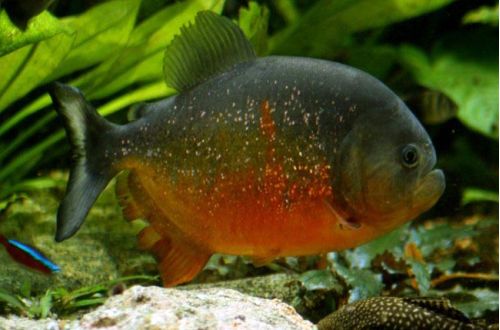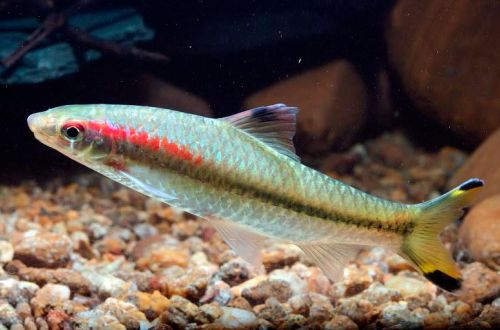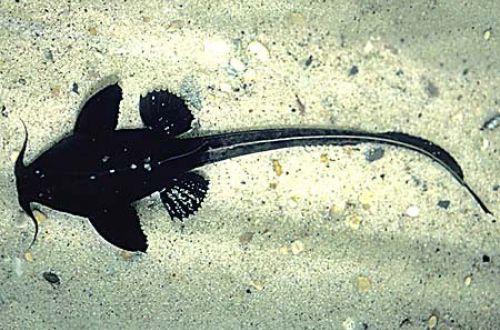
Common piranha
The Common Piranha or San Francisco Piranha, scientific name Pygocentrus piraya, belongs to the Serrasalmidae family. The name should not be misleading, this species is not related to the city of San Francisco in California. Everything is explained simply – it inhabits the river of the same name in Brazil.
Perhaps the most famous freshwater predator, popularized by many Hollywood films. Its presence in a home aquarium will inevitably arouse the interest of others, but at the same time add to the owner the hassle associated with its difficult content.

Contents
Habitat
It comes from South America from the San Francisco River basin, which flows through the eastern states of Brazil. Inhabits the main channels of rivers, tributaries, floodplain lakes and large artificial reservoirs formed by dams.
Brief information:
- The volume of the aquarium – from 400 liters.
- Temperature – 20-28°C
- Value pH — 5.0–8.0
- Water hardness – 3–23 dGH
- Substrate type – any
- Lighting – subdued
- Brackish water – no
- Water movement – light or moderate
- The size of the fish is about 30-35 cm.
- Nutrition – meat products
- Temperament – aggressive
- Content – Single
Description
Adult individuals reach a length of 30–35 cm. Fish have a massive oval-shaped body, tapering towards the tail. The dorsal and anal fins are shifted back. The head is large with a large mouth studded with sharp teeth. The back and head are gray, the colors of the lower body and abdomen vary from yellow to red. Sexual dimorphism is weakly expressed. The females appear larger and become noticeably rounder during the breeding season.
Food
Piranhas are best known as fierce predators. However, in reality this is not entirely true. This species is considered omnivorous. Although other fish form the basis of their diet, various aquatic insects and other invertebrates, as well as nuts, seeds, and fruits, make up a significant part of the diet.
In an artificial environment, they can be offered earthworms, shrimp, mussel meat, fish, etc.
You should not regularly serve animal products (beef, pork), as they contain substances that are difficult to digest.
Maintenance and care, arrangement of the aquarium
The optimal size of the aquarium for one fish starts from 400-500 liters. The format doesn’t really matter. Many breeders keep them in empty tanks for ease of maintenance. Nevertheless, a minimal set of decor is still preferable, for example, from a sandy or rocky substrate, several large snags. Live plants should be excluded, they can be eaten. Artificial vegetation is a good choice.
The fish is quite temperamental, especially during feeding, so graceful and fragile designs in the design should be excluded. The same applies to equipment, it must all be external, including the heating system.
Like any large carnivorous species, the common piranha produces a lot of waste that greatly pollutes the water. To maintain biological balance, it will be necessary to install productive filters, remove organic waste (feed residues, excrement) in a timely manner and replace part of the water with fresh water in a volume of at least 30–50% weekly.
In general, the complexity of the content depends entirely on the equipment installed in the aquarium and may well be within the power of even a novice aquarist, if a significant part of the work is done for him by automation.
Behavior and Compatibility
Distinguished by hostility to their relatives, intraspecific relationships are extremely aggressive. Content is single. As a rule, they treat other fish calmly if they are full, but the threat of predation always remains. May be compatible with larger species and some armored catfish, which have reliable protection in the form of bone plates and spikes.
Breeding / breeding
In nature, there are two reproductive cycles. The first is during the rainy season, when the water level rises. The second is during the low water period in November/December. Piranhas spawn in floodplain lakes and other regions with calm waters and dense aquatic vegetation. Spawning is rare in home aquaria. In many ways, the main problem is the size of the tank, in order to safely support two or more individuals, thousands of liters are needed, which, as a rule, is beyond the scope of the hobby aquarium.
Fish diseases
It is an unpretentious and hardy fish. Health problems are associated with injuries, poor nutrition and inappropriate water composition. In the event of the appearance of signs of illness (lethargy, change in body shape, loss of appetite, etc.), it is sometimes enough to bring the conditions of detention back to normal so that the body copes with the problem. However, in some cases, medical treatment will have to be used. Read more about symptoms and treatments in the Aquarium Fish Diseases section.





